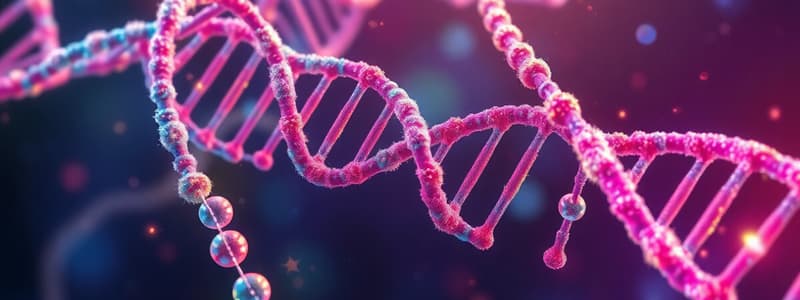Podcast
Questions and Answers
What are the two types of nucleic acids?
What are the two types of nucleic acids?
- RNA and Protein
- Polynucleotide and Mononucleotide
- Adenine and Guanine
- Deoxyribonucleic acid (DNA) and Ribonucleic acid (RNA) (correct)
Which structure is formed when nucleotides bond together?
Which structure is formed when nucleotides bond together?
- Glycosidic bond
- Hydrophobic interaction
- Peptide bond
- Phosphodiester linkage (correct)
Which nitrogenous bases are found in DNA?
Which nitrogenous bases are found in DNA?
- Adenine, Uracil, Cytosine, Guanine
- Guanine, Cytosine, Uracil, Thymine
- Adenine, Thymine, Uracil, Cysteine
- Adenine, Thymine, Cytosine, Guanine (correct)
What type of reaction leads to the formation of nucleic acid chains?
What type of reaction leads to the formation of nucleic acid chains?
What type of sugar is found in RNA?
What type of sugar is found in RNA?
How are the two strands of DNA held together?
How are the two strands of DNA held together?
Which of the following correctly describes the structure of DNA?
Which of the following correctly describes the structure of DNA?
What is the process called when RNA is synthesized from DNA?
What is the process called when RNA is synthesized from DNA?
Flashcards
What are nucleic acids?
What are nucleic acids?
Nucleic acids are complex biopolymers that play crucial roles in storing, transmitting, and expressing genetic information within organisms.
What is DNA?
What is DNA?
DNA is the blueprint for life, storing genetic instructions that determine an organism's traits. It's a double-stranded helix, with each strand composed of nucleotides.
What is RNA?
What is RNA?
RNA plays a crucial role in protein synthesis, relaying genetic instructions from DNA to ribosomes. It's a single-stranded molecule.
What is a nucleotide?
What is a nucleotide?
Signup and view all the flashcards
What are purines?
What are purines?
Signup and view all the flashcards
What are pyrimidines?
What are pyrimidines?
Signup and view all the flashcards
How do the two strands of DNA attach?
How do the two strands of DNA attach?
Signup and view all the flashcards
How does the sugar-phosphate backbone form?
How does the sugar-phosphate backbone form?
Signup and view all the flashcards
Study Notes
Nucleic Acids
- Nucleic acids are informational polymers
- They store hereditary information
- They are the only molecules capable of self-replication
- Two types: DNA and RNA
- Other functions include storing chemical energy (ATP), acting as enzymes, and as signal molecules
Types of Nucleic Acids
- Deoxyribonucleic acid (DNA)
- Ribonucleic acid (RNA)
DNA Structure
- DNA encodes the information directing cellular activity
- DNA blueprints RNA synthesis for protein synthesis
Nucleotide Structure
- Nucleotides are monomers, building blocks of nucleic acids
- Polynucleotides (DNA and RNA) are polymers
- Nucleotides form polynucleotides through condensation reactions
- A nucleotide consists of:
- Nucleoside (sugar + base)
- Phosphate group
Pentose Sugar
- Five-carbon ring sugar
- Two types: Ribose (RNA) and Deoxyribose (DNA)
- Phosphate group attaches to the 5' carbon of the sugar
Nitrogenous Bases
- Two families: Purines and pyrimidines
- Purines (two rings): Adenine and Guanine
- Pyrimidines (one ring): Cytosine, Thymine (DNA), and Uracil (RNA)
Phosphodiester Linkage
- Nucleotides bond through phosphodiester linkages, forming a sugar-phosphate-sugar-phosphate backbone
- The sugars in the backbone vary depending on the attached nitrogenous base (glycosyl bond)
DNA Structure (Double Helix)
- DNA is a double helix
- Strands held together by hydrogen bonds between complementary base pairs
- Antiparallel structure (strands run in opposite directions)
- Complementary base pairing (purine + pyrimidine):
- A – T (2 hydrogen bonds)
- G – C (3 hydrogen bonds)
RNA Structure (Single Strand)
- RNA is single-stranded
- RNA sugar is ribose
DNA vs RNA
| Feature | DNA | RNA |
|---|---|---|
| Sugar | Deoxyribose | Ribose |
| Bases | A, T, C, G | A, U, C, G |
| Structure | Double helix | Single strand |
| Function | Stores genetic information; directs RNA and protein synthesis | Involved in protein synthesis; carries genetic message; etc |
Practice Questions Answers
- d. Polynucleotide
- c. Amine
- d. Hydrogen bond
Linkages Table
| Biomolecule | Linkage |
|---|---|
| Protein | Peptide Bond |
| Carbohydrate | Glycosidic Linkage |
| Nucleic Acid | Phosphodiester Linkage |
| Lipid | Ester Linkage |
Studying That Suits You
Use AI to generate personalized quizzes and flashcards to suit your learning preferences.




